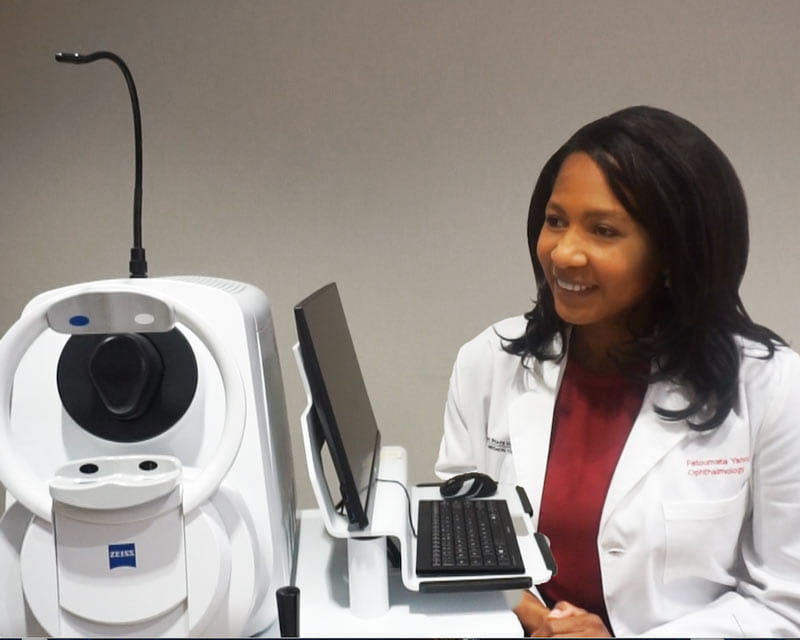
Swept-source OCT angiography reveals exquisite details of ocular structures
 A partnership between internal medicine and ophthalmology launched in the summer of 2020 with the multidisciplinary ophthalmology-rheumatology clinic to diagnose and treat patients with uveitis. Uveitis is a potentially blinding inflammatory eye condition that primarily affects younger people between 20 to 40 years of age. The condition also increase increases the risk of workforce absence and long-term disability.
A partnership between internal medicine and ophthalmology launched in the summer of 2020 with the multidisciplinary ophthalmology-rheumatology clinic to diagnose and treat patients with uveitis. Uveitis is a potentially blinding inflammatory eye condition that primarily affects younger people between 20 to 40 years of age. The condition also increase increases the risk of workforce absence and long-term disability.
Ana Suelves, MD, PhD, an ophthalmologist and the uveitis specialist at the Ohio State Wexner Medical Center, says most uveitis cases are caused by an autoimmune disorder, such as lupus, rheumatoid arthritis or sarcoidosis. Other cases can stem from trauma, cancer or infection.
“Autoimmune diseases affect different parts of the body and can lead to uveitis in the eyes,” Dr. Suelves says. “At our ophthalmology-rheumatology uveitis clinic, we can see patients with uveitis and rheumatological conditions at the same time. This is really helpful to patients because we treat them as a whole and can get to a proper diagnosis faster.”
Uveitis is a collection of more than 30 diseases that are characterized by intraocular inflammation.It occurs when there is inflammation in the uvea, the pigmented layer between the inner retina and the outer layer composed of the sclera and cornea. It’s considered an ophthalmologic emergency.
Uveitis can present with different symptoms, depending on the location of the inflammation. The most common form is anterior uveitis, which affects the interior of the front of the eye.
Symptoms typically include redness, pain and sensitivity to light. These symptoms usually bring patients to their doctor’s office quickly, Dr. Suelves says.
However, the more severe form is posterior uveitis and panuveitis. These patients typically present with mild blurry vision, haziness or floaters. Because posterior uveitis causes milder symptoms, many patients aren’t diagnosed until the condition is more advanced. Also, these patients require more often systemic treatment.
Dr. Suelves notes that few ophthalmologists specialize in this rare condition, and she stresses that a correct diagnosis is crucial to treatment success. In patients with uveitis, it’s crucial to rule out infection, malignancy and systemic diseases with impact on health (such as sarcoidosis, lupus or rheumatoid arthritis).
Most uveitis patients are in their 20s and 30s, and they need to have healthy eyes for a long time, Dr. Suelves says. Prolonged inflammation in the eye can worsen existing cataracts and make glaucoma harder to treat.
“We are more proactive now in avoiding damage to the intraocular structure because the eyes are really delicate,” she says.
“Once patients have scarring in the retina, chronic macular edema or optic nerve damage, we are late to the party,” she adds. We can prevent them from getting worse, but we can’t restore eye health that is lost.”
Dr. Suelves says anterior uveitis is typically treated with topical steroids. Posterior and panuveitis require oral, intravenous or injectable medications, as eye drops are usually not effective.
“Normally, in people who have a lot of flares of uveitis, the treatment protocol is to move to a corticosteroid-sparing therapy to retrain the immune system,” she explains. “We’ll use a course of medications for two years. The evidence shows that if we use these medications safely and successfully, we can stop the medications and the success rate of never having inflammation again in the eye is very high—about 75% to 80%.”
“To provide the best care to my patients, I like to go one step ahead and try to understand why uveitis is happening,” Dr. Suelves says. “The body is having an abnormal autoimmune response. We’re doing a lot of research to understand why this is happening and why the body is behaving in this way.”
Her latest research focuses on the role the gut microbiome plays in uveitis.
“We know that in some cases, we can treat uveitis the same way we treat other rheumatological conditions, like rheumatoid arthritis,” she says. “However, we need to better understand the role of gut health in treating uveitis. Improving or having a healthy gut microbiome brings down inflammation.”
Dr. Suelves says her research indicates that there may be a link between patients who have unhealthy gut bacteria and uveitis.
“In our patients and animal models, we’ve seen that subjects who have unhealthy bacteria in the gut present with more severe forms of uveitis,” she explains.
She’s currently enrolling patients in this new study and welcomes patient referrals.
The Ohio State University Wexner Medical Center is one of only a few medical centers in the country with a uveitis specialist. Dr. Suelves is dual-trained as a uveitis and retinal specialist and manages severe cases of uveitis
“I find it really gratifying to take care of uveitis patients,” Dr. Suelves says. “When they come to the Ohio State Wexner Medical Center, they can expect to have the best uveitis care available. Our care is highly personalized because every patient is unique.”